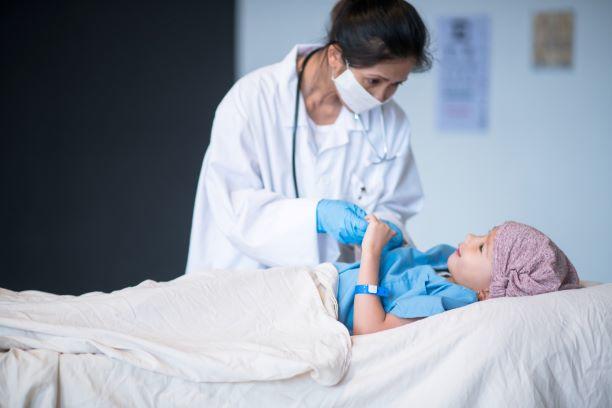, by NCI Staff
A new drug approval by the Food and Drug Administration (FDA) is expected to help address a critical need for children with leukemia who develop an allergy to a key component of their treatment.
About 15% of children with the most common type of childhood cancer, acute lymphoblastic leukemia (ALL), will develop an allergic or other immune reaction to the chemotherapy drug pegaspargase (Oncaspar). Pegaspargase is the most commonly used form of a drug known as asparaginase, which has long been an important part of treatment regimens for ALL.
An alternate form of the drug, Erwinia asparaginase (Erwinaze), can be substituted if a person develops an immune reaction to pegaspargase. However, manufacturing problems have led to global shortages of Erwinia asparaginase.
These ongoing shortages have been “incredibly stressful to patients and their parents,” said Sumit Gupta, M.D., Ph.D., a pediatric oncologist at the Hospital for Sick Children in Toronto.
And that stress was magnified when recent studies, including a Children’s Oncology Group (COG) study led by Dr. Gupta, showed that children who do not receive a full course of asparaginase are at greater risk of their cancer coming back, or relapsing.
“A lot of parents tried to move heaven and earth to find a supply of the drug for their children, and that added unneeded stress to an already stressful time,” Dr. Gupta said.
Now, there is hope that the shortages may be over.
On June 30, FDA approved a new form of asparaginase, erwinia chrysanthemi (recombinant)-rywn (Rylaze), which was developed to address the ongoing shortages of Erwinia asparaginase. Rylaze was approved as part of a treatment regimen for children and adults with ALL or lymphoblastic lymphoma (LBL), a rare but aggressive cancer that resembles ALL.
Rylaze “has the same molecular makeup as Erwinaze,” explained Malcolm Smith, M.D., of NCI’s Cancer Therapy Evaluation Program. “But it’s manufactured differently, and in a more efficient way, so having the option to substitute Rylaze should reduce the likelihood of treatment shortages for these patients in the future.”
Starving Cancer Cells of an Essential Nutrient
More than 90% of children diagnosed with ALL and LBL in the United States and Canada are cured of their disease. Treatment of ALL and LBL in people of all ages usually involves an intensive regimen of several chemotherapy drugs, including asparaginase, which works by starving the cancer cells of an essential nutrient.
Pegaspargase is a form of asparaginase that comes from E. coli bacteria and has been modified to stay in the body longer. Because asparaginase from E. coli is seen by the body’s immune system as a foreign substance, some people develop an allergic reaction to the drug, Dr. Smith explained. The immune response can also lead to a condition called silent inactivation, which essentially neutralizes asparaginase in the blood.
When these immune reactions occur, doctors usually switch their patients to an alternate form of asparaginase that is made from Erwinia bacteria. This form has been available commercially since 2011 and was available for research use for more than three decades before that, Dr. Smith said. But periodic shortages continue to this day.
“The goal is to complete the course of treatment before an immune reaction occurs,” Dr. Smith explained. “And if a reaction does occur, having an alternative form is important.”
Indeed, children with ALL who switched to Erwinia asparaginase after discontinuing pegaspargase did just as well as those who received all of the planned doses of pegaspargase, the E. coli-derived drug, Dr. Gupta said.
Several severe global shortages of Erwinia asparaginase have occurred since late 2016. The shortages led some hospitals to re-evaluate their approaches for identifying and managing immune reactions to E. coli asparaginase and conserving the use of Erwinia asparaginase.
Several hospitals that treat children with ALL made changes to their treatment protocols that allowed them to reduce the number of children who needed to switch from pegasparagase to Erwinia asparaginase. One large center reduced the switch rate from 21% to 7%, ensuring that all children were able to continue treatment without missed or delayed doses of asparaginase, and another center achieved similar results.
In some cases, however, patients and their families have been left frustrated and frightened by the unavailability of a key part of effective therapy.
The inability to provide a proven curative treatment to every patient “lends critical urgency to efforts to solve the current global Erwinia shortage or to develop alternative … products that may be used in patients with [pegasparagase] allergy,” Dr. Gupta and his colleagues wrote in their 2020 COG study.
Study of New Asparaginase Drug Is Ongoing
The recent FDA approval of Rylaze, a new form of Erwinia asparaginase, was based on data from 102 children and adults with ALL or LBL who were allergic to E. coli asparaginase or experienced silent inactivation. These patients were part of a clinical trial designed to look at the new drug’s safety and its ability to achieve certain levels of asparaginase activity in the blood, said Rachel Rau, M.D., of Baylor College of Medicine, a senior investigator on the study.
Giving the recommended dosage by injection into a muscle every 48 hours provided the target level of asparaginase activity in the blood in 94% of patients, the study found. A second part of the study is looking at injecting the drug into a vein.
Asparaginases in general can be given either intramuscularly or intravenously. The trial is studying both routes because “some doctors or patients may prefer one option over the other,” Dr. Rau explained. Full results from all patients in the study are expected to be available by 2022, Dr. Rau said.
In the study, the most common side effects of Rylaze included liver damage, nausea, fatigue, infection, and allergic reactions. More than half (55%) of participants had severe side effects.
However, Dr. Smith said, “those side effects occur with any form of asparaginase.” And, he said, the increased chance of curing a child’s leukemia outweighs the potential harms.
The company that makes Rylaze, Jazz Pharmaceuticals, expects that it will be commercially available in mid-July.
“The assumption is that Rylaze will be available and affordable and accessible to all families … and the FDA approval is a huge step” toward reaching this goal, Dr. Gupta said.







